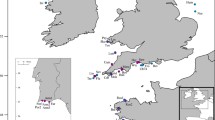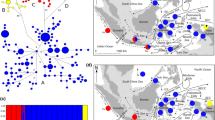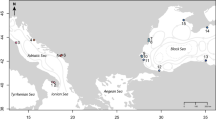Abstract
Understanding connectivity of marine organisms is necessary for determining the appropriate scale of conservation and management strategies. For species that inhabit both the coastal ocean and partially enclosed water bodies (i.e., estuaries or fjords), this information is even more critical since estuaries and fjords are often characterized by hydrological complexities which can limit dispersal potential and promote population subdivision. In this study, genetic connectivity of Dungeness crab Cancer magister in Puget Sound and coastal Washington, USA, was examined to test the hypothesis of genetic structure in partially enclosed versus open environments. Dungeness crab that were sampled at five sites in Puget Sound in 2015 and three sites in coastal Washington in 2014 were genotyped at ten microsatellite loci. We observed similar levels of heterozygosity and allelic richness within Puget Sound and coastal Washington. Pairwise F ST estimates indicated that Hood Canal was significantly differentiated from other Puget Sound sites, except Nisqually, suggesting larval retention within the Hood Canal basin. No evidence for significant genetic differentiation was found among the four remaining Puget Sound sites or among the three coastal sites. Analysis of molecular variance indicated that, in aggregate, Puget Sound sites significantly differed from coastal sites. On a site by site basis, we found evidence for significant differentiation between three sites in Puget Sound and coastal Washington. Based upon the observed patterns of genetic differentiation, our findings did not support our hypothesis of restricted genetic connectivity within Puget Sound, with the exception of Hood Canal. However, our results demonstrate that there is stronger genetic connectivity within Puget Sound and coastal Washington than between these two areas.




Similar content being viewed by others
References
Babson AL, Kawase M, MacCready P (2006) Seasonal and interannual variability in the circulation of Puget Sound, Washington: a box model study. Atmos Ocean 44:29–45
Beacham TD, Supernault J, Miller KM (2008) Population structure of Dungeness crab (Cancer magister) in British Columbia. J Shellfish Res 27:901–906
Belkhir K, Borsa P, Chikhi L, Raufaste N, Bonhomme F (2004) GENETIX 4.05: logiciel sous WindowsTM pour la génétique des populations. Laboratoire Génome, populations, interactions, CNRS UMR 5171, Université de Montpellier II, Montpellier, France
Benestan L, Gosselin T, Perrier C, Sainte-Marie B, Rochette R, Bernatchez L (2015) RAD genotyping reveals fine-scale genetic structuring and provides powerful population assignment in a widely distributed marine species, the American lobster (Homarus americanus). Mol Ecol 24:3299–3315
Benestan L, Moore JS, Sutherland BJG, Le Luyer J, Maaroufi H, Rougeux C, Normandeau E, Rycroft N, Atema J, Harris LN, Tallman RF, Greenwood SJ, Clark KF, Bernatchez (2016) Sex matters in massive parallel sequencing: evidence for biases in genetic parameter estimation and investigation of sex determination systems. bioRxiv. doi:10.1101/096065
Benjamini Y, Hochberg Y (1995) Controlling the false discovery rate: a practical and powerful approach to multiple testing. J R Stat Soc 57:289–300
Bradbury IR, Campana SE, Bentzen P (2007) Low genetic connectivity in an estuarine fish with pelagic larvae. Can J Fish Aquat Sci 65:147–158
Buonaccorsi VP, Kimbrell CA, Lynn EA, Vetter RD (2002) Population structure of copper rockfish (Sebastes caurinus) reflects postglacial colonization and contemporary patterns of larval dispersal. Can J Fish Aquat Sci 59:1374–1384
Buonaccorsi VP, Kimbrell CA, Lynn EA, Vetter RD (2005) Limited realized dispersal and introgressive hybridization influence genetic structure and conservation strategies for brown rockfish, Sebastes auriculatus. Conserv Genet 6:697–713
Camara MD, Vadopalas B (2009) Genetic aspects of restoring Olympia oyster and other native bivalves: balancing the need for action, good intentions, and the risks of making things worse. J Shellfish Res 28:121–145
Cannon GA (1983) An overview of circulation in the Puget Sound estuarine system. NOAA Technical Memorandum, ERL PMEL 48:30
Carr M, Syms C (2006) Recruitment. In: Allen LG, Pondella DJ, Horn MH (eds) The ecology of marine fishes: California and adjacent waters. University of California Press, Berkeley, pp 411–427
Chapuis MP, Estoup A (2007) Microsatellite null alleles and estimation of population differentiation. Mol Biol Evol 24:621–631
Chust G, Villarino A, Chenuil A, Irigoien X, Bizsel N, Bod A, Broms C, Claus S, Fernández de Puelles ML, Fonda-Umani S, Hoarau G, Mazzocchi MG, Mozetič P, Vandepitte L, Veríssimo H, Zervoudaki S, Borja A (2016) Dispersal similarly shapes both population genetics and community patterns in the marine realm. Sci Rep 6:28730
Ciannelli L, Knutsen H, Olsen EM, Espeland SH, Asplin L, Jelmert A, Knutsen JA, Stenseth NC (2010) Small-scale genetic structure in a marine population in relation to water circulation and egg characteristics. Ecology 91:2918–2930
Collier P (1983) Movement and growth of post-larval Dungeness crabs, Cancer magister, in the San Francisco area. Calif Fish Game Fish Bull 172:125–134
Cowen RK, Sponaugle S (2009) Larval dispersal and marine population connectivity. Annu Rev Mar Sci 1:443–466
Cowen R, Gawarkiewicz G, Pineda J, Thorrold SR, Werner FE (2007) Population connectivity in marine systems an overview. Oceanography 20:14–21
Cunningham KM, Canino MF, Spies IB, Hauser L (2009) Genetic isolation by distance and localized fjord population structure in Pacific cod (Gadus macrocephalus): limited effective dispersal in the northeastern Pacific Ocean. Can J Fish Aquat Sci 66:153–166
Diamond N, Hankin DG (1985) Movements of adult female Dungeness crabs (Cancer magister) in northern California based on tag recoveries. Can J Fish Aquat Sci 42:919–926
Dinnel PA, Armstrong DA, McMillian RO (1993) Evidence for multiple recruitment-cohorts of Puget Sound Dungeness crab, Cancer magister. Mar Biol 115:53–63
Dinnel P, Dolph I, Elder D, Woodward C, Woodard T (2011) Restoration of the native oyster in Fidalgo Bay, Washington—year nine report. Skagit County Marine Resource Committee, Mount Vernon
Doyle M, Picquelle SJ, Mier KL, Spillane MC, Bond NA (2009) Larval fish abundance and physical forcing in the Gulf of Alaska, 1981–2003. Prog Oceanogr 80:163–187
Ebbesmeyer CC, Word JQ, Barnes CA (1988) Puget Sound: A fjord system homogenized with water recycled over sills by tidal mixing. In: Kjerfve B (ed) Hydrodynamics of estuaries 2: Estuarine case studies. CRC Press, Boca Rotan, pp 17–29
Excoffier L, Smouse PE, Quattro JM (1992) Analysis of molecular variance inferred from metric distances among DNA haplotypes—application to human mitochondrial-DNA restriction data. Genetics 131:479–491
Falk DA, Richards CM, Montalvo AM, Knapp EE (2006) Population and ecological genetic in restoration ecology. In: Falk DA, Palmer MA, Zedler JB (eds) Foundations of restoration ecology. Island Press, Washington, D.C., pp 14–42
Fisher JL (2006) Seasonal timing and duration of brachyuran larvae in a high-latitude fjord. Mar Ecol Prog Ser 323:213–222
Froelich HE, Essington TE, Beaudreau AH, Levin PS (2014) Movement patterns and distributional shifts of Dungeness crab (Metacarcinus magister) and English sole (Parophrys vetulus) during seasonal hypoxia. Estaur Coast 37:449–460
Funk WC, McKay JK, Hohenlohe PA, Allendorf FW (2012) Harnessing genomics for delineating conservation units. Trends Ecol Evol 27:489–496
Gillanders BM, Elsdon TS, Roughan M (2012) Connectivity of Estuaries. In: Heip CHR, Middelburg JJ, Philippart CJM (eds) Treatise on estuarine and coastal science, volume 7: functioning of ecosystems at the land–ocean interface, vol 7. Elsevier, London, pp 119–142
Gotshall DW (1978) Northern California Dungeness crab, Cancer magister, movements as shown by tagging. Calif Fish Game 64:234–254
Goudet J (2001) FSTAT, version 2.9. 3, a program to estimate and test gene diversities and fixation indices. Lausanne University, Lausanne
Gregg MC, Pratt LJ (2010) Flow and hydraulics near the sill of Hood Canal, a strongly sheared, continuously stratified fjord. J Phys Oceanogr 40:1087–1105
Hildenbrand K, Gladics AJ, Eder R (2011) Adult male Dungeness crab (Metacarcinus magister) movements near Reedsport, Oregon from a fisheries collaborative mark-recapture study. Oregon Wave Energy Trust and the Oregon Dungeness Crab Commission, Oregon
Ivanova NV, deWaard JR, Hebert PDN (2006) An inexpensive, automation-friendly protocol for recovering high-quality DNA. Mol Ecol Notes 6:998–1002
Iwamoto E, Ford MJ, Gustafson RG (2004) Genetic population structure of Pacific hake, Merluccius productus, in the Pacific Northwest. Environ Biol Fish 69:187–199
Jamieson GS, Phillips A (1993) Megalopal spatial distribution and stock separation in Dungeness crab (Cancer magister). Can J Fish Aquat Sci 50:416–429
Jombart T (2008) Adegenet: a R package for the multivariate analysis of genetic markers. Bioinformatics 24:1403–1405
Kalinowski ST (2009) How well do evolutionary trees describe genetic relationships among populations? Heredity 102:506–513
Kaukinen KH, Supernault KJ, Miller KM (2004) Enrichment of tetranucleotide microsatellite loci from invertebrate species. J Shellfish Res 23:621–626
Kimura M, Weiss GH (1964) The stepping stone model of population structure and the decrease of genetic correlation with distance. Genetics 49:561–576
Knutsen H, Jorde PE, André C, Stenseth NC (2003) Finescaled geographical population structuring in a highly mobile marine species: the Atlantic cod. Mol Ecol 12:385–394
Knutsen H, Olsen EM, Jorde PE, Espeland SH, André C, Stenseth NC (2011) Are low but statistically significant levels of genetic differentiation in marine fishes ‘biologically meaningful?’ A case study of coastal Atlantic cod. Mol Ecol 20:768–783
Kumar G, Kocour M (2016) Applications of next-generation sequencing in fisheries research: a review. Fish Res 186:11–22
Lough R (1976) Larval dynamics of the Dungeness crab, Cancer magister, off the central Oregon coast, 1970–71. Fish B NOAA 74:353–376
Love MS, Yoklavich M, Thorsteinson L (2002) The rockfishes of the Northeast Pacific. University of California Press, Berkeley
Lowe WH, Allendorf FW (2010) What can genetics tell us about population connectivity? Mol Ecol 15:3038–3051
McFarlane GA, Beamish RJ (1985) Biology and fishery of Pacific whiting, Merluccius productus in the Strait of Georgia. Mar Fish Rev 47:23–34
McMillan RO, Armstrong DA, Dinnel PA (1995) Comparison of intertidal habitat use and growth rates of two northern Puget Sound cohorts of 0+ age Dungeness Crab, Cancer magister. Estuaries 18:390–398
Meirmans PG (2006) Using AMOVA framework to estimate a standardized genetic differentiation measure. Evolution 60:2399–2402
Meirmans PG, Van Tienderen PH (2004) GENOTYPE and GENODIVE: two programs for the analysis of genetic diversity of asexual organisms. Mol Ecol Notes 4:792–794
O’Malley K, Corbett K, Beacham T, Jacobson D, Jackson T, Roegner G (2017) Genetic connectivity of Dungeness crab (Cancer magister) across oceanographic regimes. J Shellfish Res (in review)
Pacific States Marine Fisheries Commission (2014) Revised pre-season testing protocol for the tri-state coastal Dungeness Crab Commercial Fishery. http://www.psmfc.org/crab/2013-2014%20files/2014preseasontesting.pdf. Accessed 16 July 2016
Palsbøll PJ, Bérubé M, Allendorf FW (2007) Identification of management units using population genetic data. Trends Ecol Evol 22:11–16
Palumbi SR (2003) Population genetics, demographic connectivity, and the design of marine reserves. Ecol Appl 13:146–158
Palumbi SR (2004) Marine reserves and ocean neighborhoods: the spatial scale of marine populations and their management. Annu Rev Environ Resour 29:34–68
Pante E, Simon-Bouhet B (2013) Marmap: a package for importing, plotting and analyzing bathymetric and topographic data in R. PLoS One 8:e73051
Parker MS, Jumars PA, LeClair L (2003) Population genetics of two bivalve species (Prototheca satminea and macoma balthica) in Puget Sound, Washington. J Shellfish Res 22:681–688
Pritchard C, Shanks A, Rimler R, Oates M, Rumrill S (2015) The Olympia oyster Ostrea lurida: recent advances in natural history, ecology, and restoration. J Shellfish Res 34:259–271
R Core Team (2016) R: a language and environment for statistical computing. R Foundation for Statistical Computing, Vienna, Austria. https://www.R-project.org/. Accessed 23 Sept 2016
Rasmuson L (2013) The biology, ecology and fishery of the Dungeness crab, Cancer magister. Adv Mar Biol 65:95–148
Raymond M, Rousset F (1995) GENEPOP (version 1.2): population genetics software for exacts tests and ecumenicism. J Hered 86:248–249
Reiss H, Haorau G, Dicky-Collas M, Wolff WJ (2009) Genetic population structure of marine fish: mismatch between biological and fisheries management units. Fish Fish 10:361–395
Rogers LA, Olsen EM, Knutsen H, Stenseth NC (2014) Habitat effects on population connectivity in a coastal seascape. Mar Ecol Prog Ser 511:153–163
Rousset F (2008) Genepop’007: a complete reimplementation of the Genepop software for Windows and Linux. Mol Ecol Resour 8:103–106
Schwartz MK, Luikart G, Waples RS (2007) Genetic monitoring as a promising tool for conservation and management. Trends Ecol Evol 22:25–33
Selkoe KA, D’Aola CC, Crandall ED, Iacchei M, Liggins L, Purtiz JB, von der Heyden S, Toonen RJ (2016) A decade of seascape genetics: contributions to basic and applied marine connectivity. Mol Ecol Prog Ser 554:1–19
Shanks AL (2013) Atmospheric forcing drives recruitment variation in the Dungeness crab (Cancer magister), revisited. Fish Oceanogr 22:263–272
Shanks AL, Roegner GC (2007) Recruitment limitation in Dungeness crab is driven by variation in atmospheric forcing. Ecology 88:1726–1737
Shanks AL, Roegner GC, Miller JA (2010) Using megalopae abundance to predict future commercial catches of Dungeness crabs (Cancer magister) in Oregon. Cal Coop Ocean Fish 51:1–13
Smith BD, Jamieson GS (1991) Movement, spatial distribution, and mortality of male and female Dungeness crab Cancer magister near Tofino, British Columbia. Fish Bull 89:137–148
Snow C, Wagner E (1965) Tagging of Dungeness crabs with spaghetti and dart tags. Fish Commun Oreg 4629:5–13
Stick DA (2011) Identification of optimal broodstock for Pacific Northwest oysters. Dissertation, Oregon State University
Toonen RJ, Harris ML, Gosberg R (2004) Isolation and characterization of polymorphic microsatellite loci from the Dungeness crab Cancer magister. Mol Ecol Notes 4:30–32
Vadopalas B, Leclair LL, Bentzen P (2004) Microsatellite and allozyme analyses reveal few genetic differences among spatially distinct aggregations of geoduck clams (Panopea abrupta, Conrad 1849). J Shellfish Res 23:693–706
Wainwright TC, Armstrong DA (1993) Growth patterns in the Dungeness crab (Cancer magister): synthesis of data and comparison of models. J Crustac Biol 13:36–50
Waples RS, Gaggiotti O (2006) What is a population? An empirical evaluation of some genetic methods for identifying the number of gene pools and their degree of connectivity. Mol Ecol 15:1419–1439
Weersing KA (2007) Population genetics, larval dispersal, and demographic connectivity in marine systems. Thesis, University of Hawaii
Weir BS (1996) Genetic data analysis II. Sinauer Associates, Sunderland
Weir BS, Cockerham CC (1984) Estimating F-statistics for the analysis of population structure. Evolution 38:1358–1370
Wright S (1943) Isolation by distance. Genetics 23:114–138
Yang Z, Wang T (2013) Tidal residual eddies and their effect on water exchange in Puget Sound. Ocean Dynam 63:995–1009
Acknowledgements
This report was prepared by Oregon Sea Grant under grant number NA14OAR4170064 (CFDA No. 11.417) (Project Number R/RCF-33) from the National Oceanic and Atmospheric Administration’s National Sea Grant College Program, US Department of Commerce, and by appropriations made by the Oregon State Legislature. The statements, findings, conclusions, and recommendations are those of the authors and do not necessarily reflect the views of these funders. This research was also funded by the Hatfield Marine Science Center Bill Wick Marine Fisheries Award. We thank the Washington Department of Fish and Wildlife, the Washington commercial Dungeness crab fishing fleet, and the Suquamish, Swinomish, and Nisqually Tribes for their cooperation and assistance in sampling of Dungeness crab. We would also like to thank Dr. David Armstrong (Marine Biology, University of Washington) for his comments on an earlier version of this manuscript.
Author information
Authors and Affiliations
Corresponding author
Ethics declarations
All animals were sampled in accordance with Oregon State University and national ethical standards. Permission for sampling was granted through the Washington Department of Fish and Wildlife, as well as the Suquamish, Swinomish, and Nisqually Tribes.
Conflict of interest
The authors have no conflict of interest pertaining to this study, and consent was given by Tyler M. Jackson, Kathleen G. O’Malley, and those who assisted with sampling.
Additional information
Responsible editor: O. Puebla.
Reviewed by L. Benestan and G. Winans.
Electronic supplementary material
Below is the link to the electronic supplementary material.
Rights and permissions
About this article
Cite this article
Jackson, T.M., O’Malley, K.G. Comparing genetic connectivity among Dungeness crab (Cancer magister) inhabiting Puget Sound and coastal Washington. Mar Biol 164, 123 (2017). https://doi.org/10.1007/s00227-017-3152-7
Received:
Accepted:
Published:
DOI: https://doi.org/10.1007/s00227-017-3152-7




